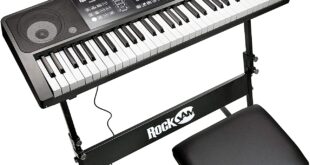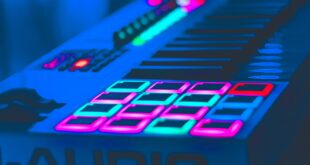An electronic keyboard, portable keyboard, or digital keyboard (according to Wikipedia) is an electronic musical instrument, an electronic or digital descendant of keyboard instruments. Broadly speaking, the term electronic keyboard or merely a keyboard can apply to any sort of digital or electronic keyboard instrument. Synthesizers, digital pianos, stage pianos, electronic organs, and digital audio workstations are all examples of an electronic keyboard. An electronic keyboard, on the other hand, is a synthesiser with a built-in low-wattage power amplifier and small loudspeakers.
With less intricate sound synthesis, electronic keyboards may reproduce a wide range of instrument sounds (piano, Hammond organ, pipe organ, violin, etc.) and synthesiser tones. Electronic keyboards are often intended for use by home users, beginners, and other non-professionals. They are usually equipped with unweighted keys. The most affordable devices lack velocity-sensitive keys, but the mid- to high-priced variants do. Most home keyboards have little, if any, digital sound editing capability. The user often chooses from a menu of pre-programmed “voices” or sounds, which include imitations of various instruments and some electronic synthesiser sounds. Home keyboards have a much lower cost than professional synthesizers. Alesis, Casio and Yamaha are among the leading manufacturers of home keyboards.
Table of Contents
Digital Piano vs. Keyboard: What is best suited for a novice player?
If you want to learn how to play the piano, purchasing a less priced instrument is a good choice. However, when you delve more into the matter, you discover that there are numerous types and models of pianos available. Let’s say you restrict your options down to two – digital pianos and keyboards. Here’s where the issue arises: digital pianos and keyboards can easily complicate your purchase decision, leaving you wondering which one to choose.
The two types often confuse many and even getting their difference becomes more challenging. And each one of them comes with unique features that are of great help to different people. With that being said, there is a vast difference between a digital piano and a keyboard.
Questions to Ask Yourself
Before we go into the digital piano vs. keyboard comparison, we need to ask ourselves some questions to help you understand the differences between the two. When it comes to purchasing an instrument for oneself, the following questions can help you make a better decision:
Which is the most mobile? Which one do you prefer? Which one makes you feel better than the other? Which is preferable for specific situations? What benefits does each provide, and how much does it cost?
There’s no need to be concerned if you still can’t find the answers.
By the end of this article, you will have a better understanding of each instrument and which fits you best you and hopefully be able to answer each of the questions above.
The Difference Between Digital Piano and Keyboard
If you want to find your learning and practice instrument, it is essential to understand the basics of a digital piano and a keyboard.
Piano Digital
Digital pianos are designed to be digital replicas of acoustic pianos. They might be a furniture upright type, a cabinet, or just a piano with a stand and 88 fully weighted keys. They are intended to provide you with the same touch and sensation as an acoustic piano.
Keyboard
Keyboards are primarily designed to provide mobility to artists. They are quite light, and the majority of them come with 61 or 76 keys. Keyboards are often played in “keyboard style,” in which the rhythms and accompaniments are used. In general, you select a drum from the keyboard, then play notes with your left hand and melodies with your right.
The keyboard creates a band playing, your left-hand plays 3 or more notes, and your right-hand plays the tunes. Keyboards also come with hundreds of tones and contains a lot of technical options allowing players to customize the sounds fully.
Detailed Digital Piano vs. Keyboard Comparison
Price
Digital pianos are most cost-effective if you want to learn like a pro and experience the authentic feel and touch of a real piano. Keyboards, on the other hand, they are most inexpensive among the pianos. They are excellent choices to introduce pianos to young children and beginners who have never played musical instruments before. Therefore, if you are looking for a more affordable instrument than digital pianos, you can go for a keyboard.
Space and Portability
Portability is one of the major factors that most people look for when going for musical instruments. If you have a free space that can hold a piano, it is good to go for a digital piano. However, if you have limited space or you need an instrument that you can carry along with you, keyboards are a perfect fit for you. They are lightweight and compact compared to digital pianos making them perfect fit for travel musicians. The instruments are built to last long even with much loading and unloading.
Sound Quality and The Feel
When comparing electric piano vs. keyboard, sound quality and feel are some of the most important areas to discuss. Digital pianos are designed to produce sound and feel like an acoustic piano. Their sound quality comes by taking the best acoustic piano sound samples and recording them with impressive technology. This, however, doesn’t mean that they are perfect stimulation of acoustic one, but it gets better with a high-end digital piano.
They also come with additional sounds from different instruments and a set of effects making performance even more versatile. Keyboards are also enjoyable instruments for learning and practice. They come with great features that can be used in music making and learning. They, however, do not give you the authenticity that you can find in an acoustic or a digital piano.
When it comes to keys feel, digital pianos come with technology known as Graded Hammer key action that makes them more sensitive to pressure. Keyboards, on the other hand, come mostly with soft keys that don’t have the graded key action. You can, however, find this to some high-end keyboards with this feature.
Pedals
Pedals are essential for players to show the expression and feel of the musical performance. This crucial aspect is only covered in digital pianos where you can even find three pedal system to enhance expressiveness in your playing.
Samples
A sample is a short audio recording of the sound of a musical instrument or any other sound (ocean waves, sirens, wind, etc.). Excerpts from recorded songs can also be used as samples. A five-second bass guitar riff from a funk song, for example, can be used as a sample.
Acoustic pianos aren’t the only instruments that can be sampled. Guitars, strings, organs, electric pianos, drums, flutes, strings, and a variety of other musical instruments all employ it.
Samples are typically captured at several velocity levels (multi-samples) to respond intuitively to how you play the keys (from the softest pianissimo to the loudest fortissimo).
The sound will be more realistic and accurate if the samples and technology utilised to make (or record) them are of higher quality. In recent years, technology has advanced to the point that high-end digital pianos can produce sound that is nearly identical to that of a real piano. Manufacturers capture each note performed at varied levels using numerous high-fidelity microphones in a professional recording studio with a precisely tuned acoustic piano (often a grand piano).
The ultimate sound you get depends on many factors:
- The sound and condition of the instrument were recorded using an acoustic piano.
- The equipment that was utilised to record the sound.
- During the recording, the mic(s) are placed.
- The auditory environment in which the sample took place.
- String resonance, damper resonance, cabinet resonance, natural reverberation, and other complicated tonal interactions are modelled using post-processing and algorithms.
- On a digital piano, the length of the samples and the amount of memory allotted to them.
- For each note, the number of velocity layers recorded. The more velocity layers you have, the more natural volume transitions you’ll achieve and the more expressive you’ll be.
- In general, more memory means that a digital piano can keep longer/higher-quality samples with more velocity layers.
Because lower-cost devices have less memory, producers must adopt a different strategy.
Rather than recording each individual key on an acoustic piano, they capture every second or third note and then extend the samples to fill in the gaps using modelling technology. Furthermore, many manufacturers take off a portion of the sample to lower its size in order to avoid consuming gigabytes of sampling data.
Types of Digital Pianos
The goal of a digital piano is to mimic the feel and sound of an acoustic piano as nearly as possible.
However, not all digital pianos are the same. There are various varieties of digital pianos, and you may prefer one over another depending on your demands and budget.
PORTABLE TYPE
Portable digital pianos, commonly referred to as “slab pianos,” are the most common sort of digital piano. The design of these instruments is their most significant asset.
They don’t come with a base (stand), but they can be easily moved around and stowed when not in use, just as portable keyboards.
The fundamental difference between portable digital pianos and portable keyboards is that portable digital pianos, like acoustic pianos, contain a full range of 88 hammer-action keys. They’re a lot heavier than non-weighted keyboards, but they’re still a lot lighter than acoustic keyboards.
Due to higher quality samples, a greater polyphony count, and a wider dynamic range, the sound quality is also better.
Portable pianos are popular due of their low cost.
CONSOLE TYPE
The second most common form of digital piano is the console model.
In terms of tone, touch, and appearance, they are the most similar to an acoustic piano.
Console digital pianos are distinguished from their portable equivalents by a furniture-style cabinet and three pedals that mimic the feel and appearance of an acoustic piano.
The console design has a number of positive and negative aspects. You won’t need to buy a separate stand or pedals. interior design with a digital piano. A console digital piano will be a lovely addition to your home decor thanks to its gorgeous, acoustic-like look. Nonetheless, here are the major drawbacks of console pianos: dimensions and weight
Most console pianos weigh between 70 and 150 pounds and are designed to be kept in one location.
Yes, you can move them around more easily than standard pianos, but keep in mind that they aren’t made to be moved around a lot. The price of a digital piano is mostly determined by how closely it resembles a real acoustic piano. The quality of the action, sound samples, and speaker system, as well as other components that enhance the playing experience, improves as the price rises.
UPRIGHT STYLE
Digital pianos that are upright are a subset of console digital pianos. They have large, opulent cabinets that look almost comparable to those of an upright piano.
This is the most expensive digital piano available (not counting digital grands and hybrids). You get an acoustic piano’s design as well as a sophisticated hammer action (typically with wooden keys), very detailed samples, and a multi-track player.
DIGITAL GRAND PIANOS
This is the most expensive and least frequent type of digital piano.
Many digital grand pianos from major manufacturers (such as Yamaha, Roland, and Kawai) are more expensive than a new upright piano. These, like upright-style digital pianos, provide an uncompromised playing experience, with state-of-the-art speaker systems delivering huge, powerful sound. The grand piano’s large body aids in producing an amazingly deep, resonant sound that closely matches that of a real grand piano.
ARRANGER TYPE
Although this is technically not a form of digital piano, I have opted to regard it as such.
Simply described, an arranger digital piano is a digital piano (portable OR console) that has functionality similar to those found in arranger keyboards. What sets them apart is that they include detailed piano samples and 88 hammer action keys in addition to all of the added features.
Unlike traditional digital pianos, these devices include a vast array of sounds, rhythms, tunes, effects, and recording capabilities. As a result, their control panels are frequently packed with buttons and dials, as well as displays, in order to enhance the user experience.
All of these added capabilities make these digital pianos a compelling choice for non-professional music production, writing, and experimenting with a wide range of musical instruments and styles.
STAGE PIANOS
Stage pianos are built to accommodate live performances. Rather than attempting to imitate an acoustic piano, they strive to be a portable, gig-friendly option for usage on stage or in the studio. Stage pianos, like digital pianos, emphasise authentic piano tones and realistic touch response.
However, a good selection of electric piano tones, organs, and a modest synth section are typical. The front panel has also been simplified, with a focus on hands-on control and the ability to make quick changes on the go. When it comes to controls, stage pianos excel at sound shaping, with a variety of sound effects and characteristics that can be tweaked to achieve the “perfect” sound.
Stage pianos do not usually have built-in speakers, which is the most visible difference from traditional digital pianos. This is due to the fact that they are meant to be used with an external amplifier or PA system.
Types Of Keyboards
PORTABLE ARRANGER KEYBOARDS
Beginners frequently pick a portable keyboard as their first instrument for learning the piano. The main reason for this is that portable keyboards are inexpensive. It’s an appealing alternative for a novice who isn’t 100% devoted to mastering the piano because it avoids overspending before determining whether or not they’ll persist with it. Because portable keyboards seldom ever deliver a comparable level of realism in terms of sound, you won’t be able to truly comprehend or experience what it’s like to play a genuine piano.
It’s an appealing alternative for a novice who isn’t 100% devoted to mastering the piano because it avoids overspending before determining whether or not they’ll persist with it.
Because portable keyboards scarcely provide a comparable level of realism in terms of sound, but especially touch, you won’t be able to truly comprehend or experience what it’s like to play a genuine piano.
A common portable keyboard has 76, 73, or 61 semi-weighted or non-weighted keys and costs between $100 and $300.
Semi-weighted action, unlike fully-weighted action on digital pianos, does not use hammers to simulate the feel of an acoustic piano.
Aside from the cost, there are a few other benefits of using a portable keyboard.
First and foremost, as their name implies, they are portable.
Most of these keyboards weigh around 10-15 pounds, making them easy to transport. They can be placed on a table and stored when not in use. Another benefit of portable keyboards is the variety of additional features and functionalities they offer.
Hundreds of sounds, tunes, rhythms, and other “bells and whistles” are included with most portable keyboards.
While I prefer quality over quantity, and many of the pre-programmed tones sound plasticky and artificial, these capabilities are unquestionably beneficial to people who want to experiment with various instruments and styles while still having fun with interactive elements.
As a result, portable keyboards are a popular choice among children and those just starting out in the musical world. As I previously stated, it all boils down to your individual requirements and desired outcome.
SYNTHESIZERS
Synthesizers are electronic keyboards that can generate or copy a wide range of sounds. They are extensively employed in music production.
Synths allow you to make practically any sound you can think of, including musical instruments, voices, the wind, a blast, a siren, an automobile, and the list goes on and on. They come with a set of basic waveforms and pre-recorded sounds, which you can mix together, as well as alter the sound’s attack, sustain, decay, and release time, add filters and effects to get the exact sound you need.
ARRANGER KEYBOARDS / WORKSTATIONS
Arrangers are generally for professional musicians, and they offer a wide range of backing tracks (chord and rhythm patterns) to match the style, rhythm, and pace of whatever you’re playing. This enables composers and songwriters to quickly and simply produce an accompaniment for a song without having to hire musicians to play all instruments live.
MUSIC WORKSTATIONS
A keyboard workstation is similar to a computer that is housed within a keyboard. Workstations integrate a number of tools to enable users to execute a variety of tasks, such as sound synthesis, sequencing, audio recording, and working with sound effects/filters, among others. They frequently come with hundreds, if not thousands, of high-quality sound samples that may be tweaked using knobs and sliders that allow you to control various sound parameters on the fly.
MIDI CONTROLLERS
A MIDI controller (also known as a MIDI keyboard) is a device that generates and sends MIDI data to other electronic devices that may understand it and use it to trigger sounds or change sound settings. A standard MIDI controller is a piano-style keyboard that connects to a computer by USB or MIDI ports and transfers MIDI data to it.
There is no sound engine inside MIDI controllers, thus they can’t make any noises on their own. They just keep track of your keypresses (velocity, length, and pressure) as well as different control elements.
Best Electric Keyboard Piano Options
Technical Details
Brand: Rockjam
Product Dimensions: 69.8 x 23.5 x 8.4 cm; 1.66 Kilograms
Item model number: RJ549
Colour: Black
Connector: /
Scale Length: Inches
Number of Keyboard Keys: 49
Output Wattage: 5 Watts
Size: Compact 49 Keyboard Piano
Proficiency Level: Beginner
Power Source: Battery Powered
Item Weight: 1.66 kg
The RockJam 761 keyboard piano super kit includes an electronic keyboard with 61 full-size keys giving you that traditional piano feel whilst maintaining a portable and compact design that can be powered by either main (power supply included) or batteries. It features a touch display panel that both displays feedback and engages the 200 rhythms, 200 tones, a teaching function, and 30 demo songs that are part of its functionality. It has record and playback functionality allowing you to build layers to your sound and the midi output integrates with your digital audio workstation like Ableton and logic via a single cable. This music keyboard super kit package includes a keyboard stand that is sturdy in design and can be adjusted to suit keyboard piano players both young and old. This electric piano keyboard super kit contains a padded seat that is easily folded and has a thick padded seat for hours of comfortable play, over-ear headphone so you can practice in privacy, and a sustain pedal.
Technical Details
Brand: Rockjam
Style: 61 Key Keyboard Piano Kit with Touch Display
Product Dimensions: 90.42 x 32 x 10.92 cm; 5.44 Kilograms
Item model number: RJ761-SK
Colour: Black
Connector: /
Scale Length: Inches
Number of Keyboard Keys: 61
Output Wattage: 10 Watts
Standing screen display size: 3
Proficiency Level: Beginner
Voltage: 120 Volts
Item Weight: 5.44 kg
Technical Details
Brand: Eastar
Style: EK-10S
Product Dimensions: 95 x 29 x 71.5 cm; 14.96 Kilograms
Item model number: RJ761-SK
Colour: Brown
Hardware Interface: 3.5mm Audio, Headphone
Scale Length: Inches
Number of Keyboard Keys: 61
Item Weight: 15 kg
This multi-function keyboard piano features 61 keys is made of non-toxic and environmentally-friendly plastic. Designed for beginner to intermediate-level use, providing a traditional piano feel for versatile learning and an exciting acoustic experience.It is suitable for adults and beginner. ZHRUNS full Size 61 keys piano features record and playback so that beginners can learn and play the piano more easily and quickly.The keyboard have many different tones, rhythms, and melodies, you can play different music. Each keyboard has 60 demo songs, 200 rhythms, 200 tones, you can create unlimited compositions with this multifunctional instrument! If you hesitate to practice in front of someone, look for a headphone so that only you hear your music when you play.
Technical Details
Brand: ZHRUNS
Product Dimensions: 120 x 10 x 27 centimetres
Item model number: RJ761-SK
Colour: Black
Scale Length: Inches
Number of Keyboard Keys: 61
Item Weight: 3.7 kg
This RockJam 61 key keyboard piano has 200 rhythms and tones, 40 demo songs, a 46 note record, and playback function, and two inbuilt teaching modes. This electric keyboard comes with a mains power supply but can also be powered by batteries
Technical Details
Brand: Rockjam
Style: 61 Key Keyboard Piano Kit with Touch Display
Product Dimensions: 80 x 7.8 x 28 centimetres
Item model number: RJ361
Colour: Black
Connector: /
Scale Length: Inches
Number of Keyboard Keys: 61
Output Wattage: 6 Watts
Standing screen display size: 3
Proficiency Level: Beginner
Voltage: 100240 Volts
Item Weight: 13.6 g
 The Occasional Orchestra Learn About Everything Music!
The Occasional Orchestra Learn About Everything Music!








